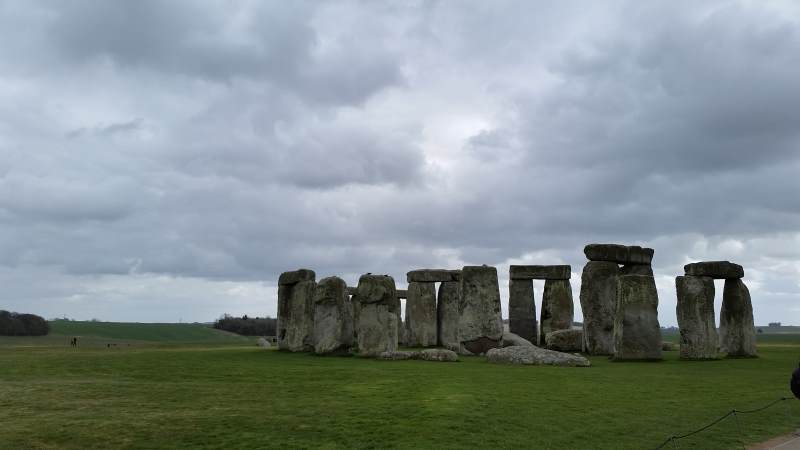My wife, Chrissy, and I have just returned from a trip to England. The three week break was a chance to see my family, visit some old friends, and have a vacation. Before we left for the UK, Chrissy expressed an interest in visiting Poole in Dorset (the reason why is for another time), so I suggested we should stop by Stonehenge as it is on the way and Chrissy had never been.
Tickets and Time Slots
It had been a long time since the one and only time I had visited Stonehenge, so I decided to do some research on the English Heritage website. It was there that I discovered Stonehenge now requires advanced booking to guarantee seeing it. Tickets cost £15 (about $25) each for adults and cover parking, access to the onsite museum, and access to Stonehenge itself (checkout the site for up-to-date pricing information). When I visited Stonehenge as a kid, the site had only just earned World Heritage status. Visitors would drive up to the site, park their car, and have a walk around for free or close to it, so £15 seemed a tad expensive. In hindsight, I can see where the money goes and for me (and Chrissy) it was worth it1.
When booking the tickets, you have to select a half hour time slot in which you will arrive at the site. This time slot does not affect how long you can stay, it just staggers arrivals to provide some level of crowd control. I selected a slot in the early afternoon to give us time to get there, although I was somewhat anxious about being able to meet our half hour slot; the website clearly states that missing your slot may mean you cannot visit the site and there are no refunds. In England, journey times can be exceedingly variable due to the high volume of traffic, and due to a combination of other commitments and traffic, I was right to be anxious. As we traveled to Stonehenge from Poole in Dorset, Chrissy called ahead to let them know we would be about an hour late. The staff that we spoke to were very helpful in adjusting our time slot and giving us a new reference code at no extra charge. I could imagine that on a busier day, they might not have been able to help us and we would not have been able to visit.
Stonehenge Visitor Centre
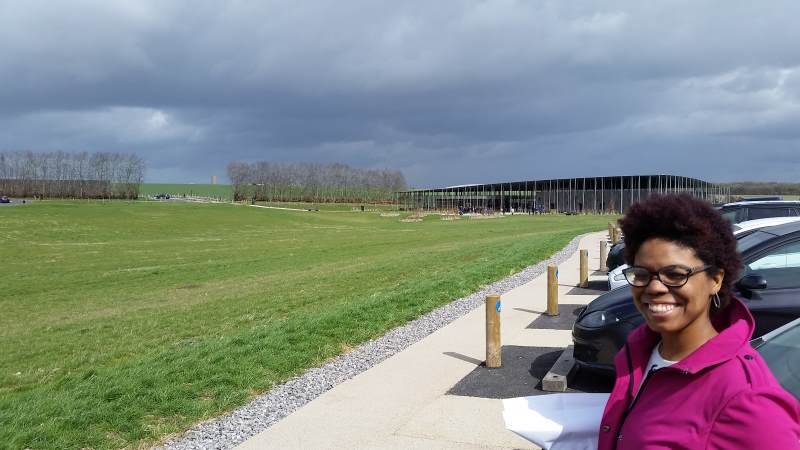
Upon arrival, our advanced booking ticket gave us access to the car park. For those without advanced booking, parking was £5, refundable on buying a ticket (I suppose this fee is to discourage people just stopping by to use the toilets or grab a snack). However, drop-in visits cost nearer £18 each (and I assume would be subject to availability based on how busy they are). Given this information, I highly recommend getting advanced tickets. I also recommend making your time slot and if you cannot, calling ahead rather than just waiting to get there.
Visiting Stonehenge from London
Stonehenge is not quite as close to London as the movies often make out. The monument is roughly an hour and forty minutes from London by car (depending on traffic), or nearly four hours by public transportation.
Parking, situated a mile or two from Stonehenge itself, was easy. As we stepped out of the car, the exposed nature of the area was evident. Outside the shelter of the visitor centre, the wind was strong and biting. Having experienced it without, I definitely recommend dressing in layers, including scarf, gloves, and hat, just in case the weather is inclement.
From the car park leads a path to the new and impressive visitor centre. Inside which is an extensive gift shop2, a cafeteria, toilets (these were clean and well-maintained), and a museum. We grabbed some food before exploring more and found it to be excellent if not a little overpriced; somewhat reminiscent of Ikea but with less meatballs.
Neolithic Village

At the back of the visitor centre is an open air imagining of a neolithic village containing several roundhouses. After eating in the cafeteria, we decided to check that out first. Each roundhouse represents a possible example of neolithic life, based on archaeological discoveries and expert conjecture.
In one roundhouse we discovered an English Heritage staff member displaying various examples of neolithic tools and clothing. We spent a few minutes talking with the guide about the roundhouses, neolithic life, and clothing (nettle-based thread is surprisingly soft, somewhere between cotton and hessian). The neolithic village was my favourite part of the visitor centre area. Not only were the roundhouses a great tactile, visual, and informative experience, but the nearby sarsen stone challenge was an amusing distraction.
Stonehenge
After visiting the neolithic village, we jumped aboard one of the shuttle buses that connects the visitor centre with Stonehenge. If you wish, you can opt to forego the shuttle and walk to Stonehenge. However, the shuttle and walking are the only options as the road to Stonehenge, once accessible by the public, is now closed to all but walkers, the shuttle buses, and other authorized vehicles.
The ride took about two minutes and was surprisingly exciting. As the shuttle bus neared Stonehenge, the monument rose out of the horizon. I found the experience more exciting than I had expected, though part of that was driven by Chrissy's obvious excitement next to me. Arriving near Stonehenge, I stepped off the shuttle bus and began regretting not having gloves, a scarf, or a hat; the wind was intense.
The shuttle bus drops off and picks up close to where the old visitor centre used to be. As we walked toward Stonehenge, debris from that visitor centre and some portions of the old car park were visible on our left. English Heritage is in the process of returning the Stonehenge area to a more natural state, so the old visitor centre has been demolished and soon the old car park will be entirely gone.
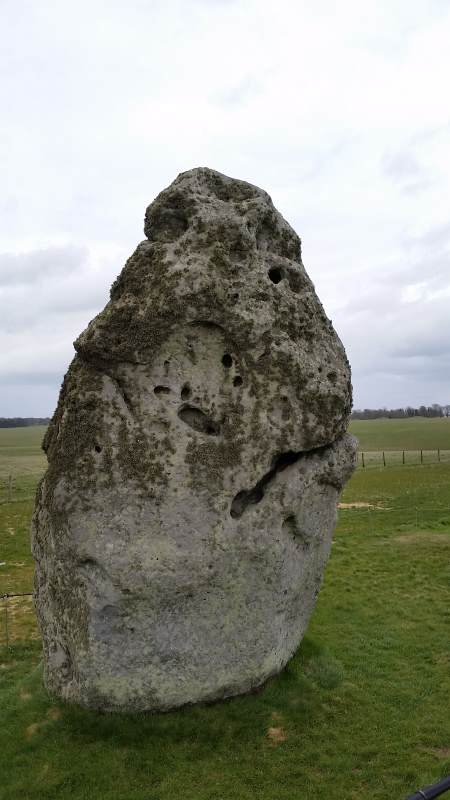
From the bus stop, a footpath leads up toward Stonehenge. The path was varied in width and roped on both sides, it was also protected in places with a porous matting under foot. We followed the path until we reached a fork near Stonehenge. The audio tour (available as a smartphone app) directs you in a specific direction although, due to the wind and our desire to talk to one another as we shared the experience, we turned the tour off and went to the left. This took us up to the Heel Stone, a large, unshaped, upright sarsen stone that is one of two remaining Station Stones (there used to be four). From the Heel Stone, the view descends away from Stonehenge along the Avenue that leads to Woodhenge near the river Avon and a settlement.
Walking past the Heel Stone takes visitors away from the main site a little, passing down the other side of the hilltop. This gave us an opportunity to view Stonehenge from a distance and appreciate the site and its imposing silhouette against the sky. As we walked around the path, it was possible to see various burial mounds positioned on all sides such that they appear on the horizon when stood close to the henge. While visiting we learned that to the people who built this site, it is likely that stone represented death and wood represented life, explaining the arrangement of burial sites with Stonehenge, and the settlement with Woodhenge. These burial mounds and the other earthworks, such as the Avenue, surrounding Stonehenge are all part of the World Heritage site maintained by English Heritage.
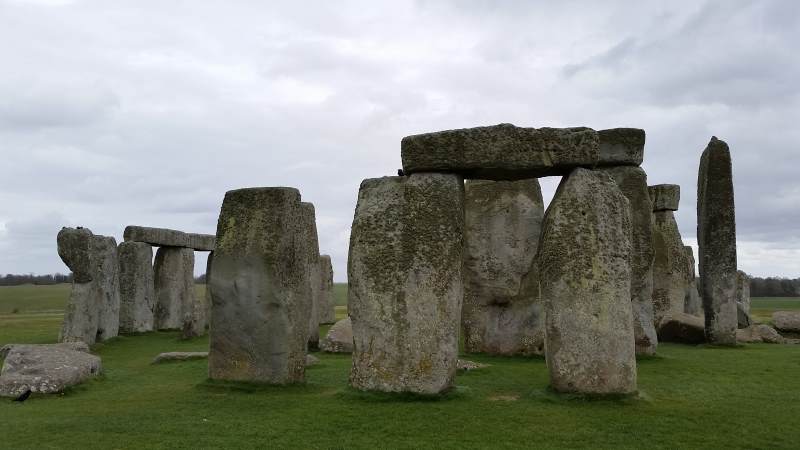
From the furthest point, the footpath spiraled back in toward Stonehenge until we were within a few feet of the giant stones. Just as when I was a child, the stones themselves are now roped off from visitors to protect the site from damage and vandalism, signs of which are still visible to those who look. However, signs of more well-intentioned changes are also visible, such as the cement repairs that were made to the henge in order to maintain its state of arrested decay3.
From atop the stones, rooks launched themselves into the unrelenting wind, flapping their wings with determination yet going nowhere. From the number of birds taking part and the repetition of this Sisyphean task, I am pretty certain this was a game used to pass the time while waiting for people to throw them a snack.
Museum
After spending around 45 minutes around Stonehenge, we caught the shuttle bus back to the visitor centre, purchased some gifts from the visitor centre4, and checked out the museum. Access to the museum is included as part of the ticket price. The museum itself is not very big and so easy to cover in an hour or so. Entrance and exit to the museum is via a circular room with projection onto the outer walls simulating what being inside the famous stone circle would be like at various parts of the year; notably, the winter and summer solstices. The main area of the museum contains various exhibits and artifacts from Stonehenge and the surrounding area, discussing its history and archaeology. There is also a special area for housing temporary exhibits, which for our visit covered Stonehenge and its relationship to war with various artifacts from the various military bases that were in the area. Overall, the museum was a great way to end the visit, although I could see it being a decent way to begin too if you were less eager to get to see Stonehenge.
In Conclusion…
After the museum, we grabbed a snack, took a bathroom break, and headed home. Our route took us along the A303, which runs east-west just south of Stonehenge. Stonehenge is visible from this road and, as such, this road is visible from Stonehenge5. The view from the road, though impressive, was not a patch on our visit.
The museum, neolithic village, and Stonehenge itself all provided unique experiences that, together with some breath-taking views of the surrounding landscape and a bite to eat, took around two and a half enjoyable hours. The hands-on elements of the neolithic village, the immersive audio tours, and the new facilities would all have been well received by me (and my parents) had they been there when I visited as a child. I definitely think families would get a lot from a visit.
In conclusion, Stonehenge and the Stonehenge Visitor Centre are wonderful if you have an interest in the neolithic and related subjects, or a general enjoyment of museums, but you should set expectations the same as you would visiting any museum; if you are expecting some kind of life-changing experience or spiritual awakening from your visit, you will most likely be disappointed. For those wanting a more exclusive experience, you can contact English Heritage to try and arrange a visit into the stone circle itself, though I suspect that experience is only slightly more whelming than the one most of us get. Either way, if you have the opportunity, I would definitely recommend a visit to Stonehenge.
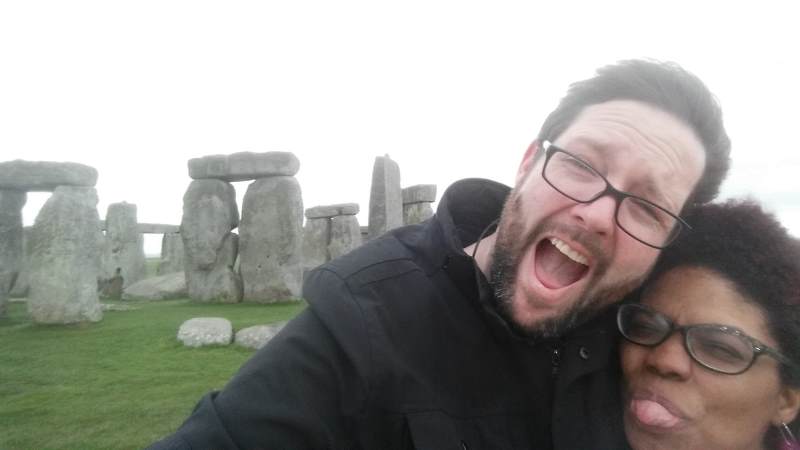
This post is sponsored by CompareStonehengeTours.com

- If the ticket price is still putting you off and you don't mind crowds, access to the monument is free on the solstices [↩]
- "Exit through the gift shop" culture is everywhere now, as we already know [↩]
- If you search the Internet, you can find discussions on the various restoration or maintenance efforts conducted at Stonehenge, and forthright opinions on whether they went far enough or too far [↩]
- I am certain that the packet of 10 Stonehenge-themed tissues were very well received [↩]
- Although now cancelled due to ever increasing costs, a project had been proposed to construct a tunnel for the A303 to improve the landscape around the monument and to improve road safety (as you might imagine, rubbernecking is pretty common) [↩]

